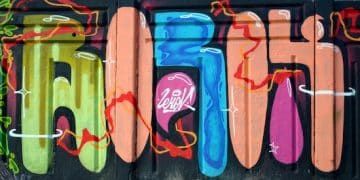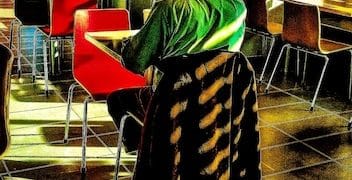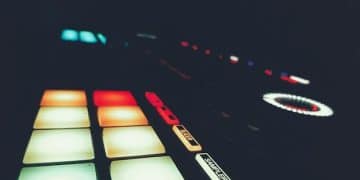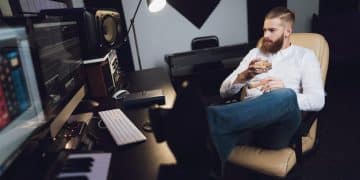Sampling Legally: Copyright for Underground Music Producers US
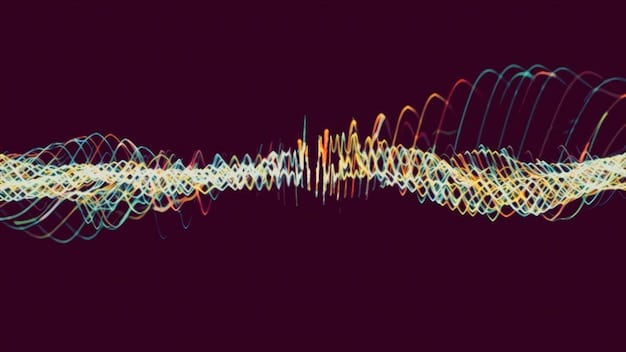
For underground music producers in the US, navigating copyright law for sampling is essential, requiring a clear understanding of legal requirements to avoid infringement and ensure creative longevity.
For many underground music producers in the US, the creative process often involves Sampling Legally: A Guide to Copyright Law for Underground Music Producers in the US. This practice, while fundamental to various genres, brings forth a complex web of legal considerations, particularly concerning copyright. Understanding these nuances isn’t just about compliance; it’s about safeguarding your artistic future.
the art and legality of sampling
Sampling, at its core, is the act of taking a portion of one sound recording and reusing it in a different song. It’s a cornerstone of genres from hip-hop to electronic, evolving alongside technology and shaping musical landscapes worldwide. However, this creative freedom operates within the stringent boundaries of copyright law.
In the United States, two primary copyrights apply to any recorded music: the copyright in the sound recording (often owned by the record label) and the copyright in the underlying musical composition (owned by the songwriter(s) and/or publisher). To legally sample, you generally need permission for both, a dual clearance process that can be daunting, especially for independent and underground artists.
understanding sound recording copyright
The sound recording copyright protects the specific performance and recording of a musical work. Think of it as the master tape. Even a tiny snippet from an existing recording falls under this protection. Unlicensed use can lead to significant legal repercussions, including injunctions to halt distribution and substantial monetary damages.
- Master Use License: This is the permission required from the owner of the sound recording. It grants you the right to use a specific portion of the recorded sound.
- Negotiation: Terms are often negotiated, encompassing flat fees, per-unit royalties, or a combination. The cost can vary wildly depending on the original song’s popularity and the length/prominence of the sample used.
- Challenges for Underground Producers: Accessing these licenses can be difficult due to high costs or reluctance from copyright holders to grant permission, pushing some artists into risky territory.
considering musical composition copyright
Separate from the sound recording, the musical composition copyright protects the melody, lyrics, and arrangement of a song. This is the intellectual property created by the songwriter. Using a sampled portion of a song, even if re-recorded by another artist, still requires clearing this right.
For underground producers, ignoring this distinction can be a common pitfall. Re-playing a beat or melody from another song to avoid master clearance doesn’t absolve you of the need for a mechanical license for the underlying composition if it’s a direct reproduction of the copyrighted work. Understanding this dichotomy is crucial for a lawyerly approach to your craft.
The landscape of sampling law is complex and ever-evolving, driven by landmark court cases that have reshaped how artists approach using pre-existing materials. Ignorance of the law is not a valid defense, and the consequences for infringement can be severe, ranging from cease-and-desist letters to costly lawsuits that can bankrupt an emerging artist. Therefore, producers must adopt a proactive and informed approach, ensuring they navigate these waters with diligence and foresight.
the legal gray areas and misconceptions
While the fundamental principles of copyright law concerning sampling appear straightforward, a multitude of misconceptions and legal “gray areas” often ensnare underground producers. These misunderstandings can lead to costly mistakes, underscoring the critical need for accurate information and sound legal advice.
the “short sample” myth
One prevalent myth is that using a very short sample—say, a “two-second rule” or “four-bar rule”—is automatically legal and exempt from copyright infringement claims. This is unequivocally false. US copyright law does not prescribe a minimum length or duration for a sample to be considered infringing. Even the smallest, most unrecognizable fragment can still render an artist liable if it’s proven to be copied from a copyrighted work.
Courts have consistently held that the quantity of the original work sampled is not the sole determinant of infringement. The qualitative significance of the sampled portion and its recognition in the new work also play crucial roles. A distinctive one-second drum hit or a unique vocal ad-lib could be just as infringing as a longer melodic phrase, especially if it’s central to the original song’s identity.
“fair use” and its limitations
The concept of “fair use” under US copyright law is often cited by artists hoping to justify unlicensed sampling. While fair use offers a defense against copyright infringement, its application is highly specific and rarely a safe harbor for typical music sampling. Fair use is determined on a case-by-case basis, considering four primary factors:
- Purpose and character of the use: Is it commercial or for non-profit educational purposes? Transformative uses (where the sample is altered significantly to create something new) are favored, but courts are cautious about musical sampling.
- Nature of the copyrighted work: Is the original work factual or creative?
- Amount and substantiality of the portion used: How much of the original was copied, and how important was that copied portion to the original work as a whole?
- Effect of the use upon the potential market for or value of the copyrighted work: Does the new work compete with or harm the market for the original?
For underground music producers, arguing fair use for sampling can be an uphill battle, particularly if the new track is intended for commercial release or generates revenue. Courts are generally skeptical of fair use claims when samples are used to create new commercial records, as it directly impacts the potential licensing market for the original work. The bar for “transformative” use in music sampling is set very high, often requiring a radical alteration that makes the original unrecognizable or uses it for satirical/critical commentary, which is rare in standard beat-making.
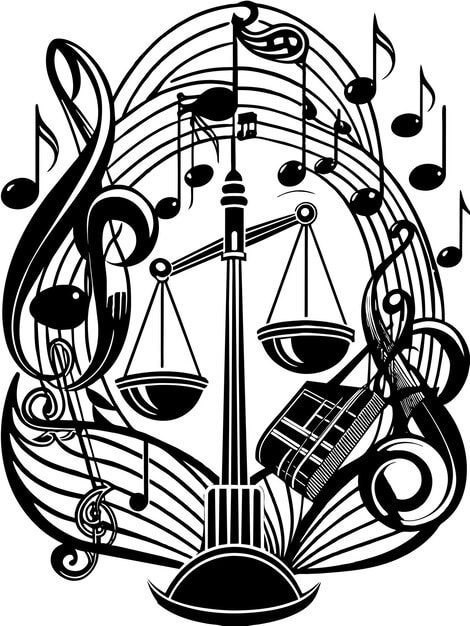
Another common misbelief is that if a track is only distributed for free or non-commercially, it’s exempt from copyright claims. While the commercial nature of a use is a factor in fair use analysis, it doesn’t grant blanket immunity. Copyright holders still have the right to protect their work, and even free distribution can be considered an infringement if it violates exclusive rights such as reproduction or public performance.
In essence, relying on these legal gray areas without proper counsel is akin to walking a tightrope without a safety net. The best practice remains to secure proper licenses or ensure your work falls outside the realm of copyrightable material borrowed from others.
the process of clearing samples
For underground music producers contemplating the path of legal sampling, understanding the comprehensive process of clearing samples is paramount. This isn’t merely a formality; it’s a critical step that secures your legal footing and fosters a respectful relationship within the creative community. The process can be intricate and sometimes costly, but it offers invaluable peace of mind and protection against future legal entanglements.
identifying copyright holders
The first and most challenging step is often identifying who owns the copyrights to the sound recording and the underlying musical composition. This requires diligent research. For the sound recording, this usually means finding the record label that released the original track. For the musical composition, it involves identifying the songwriter(s) and their publishers. Resources like ASCAP, BMI, SESAC, and the U.S. Copyright Office’s public records can be invaluable tools in this investigative phase.
- Performance Rights Organizations (PROs): Organizations like ASCAP, BMI, and SESAC manage performing rights for songwriters and publishers. Their databases can help identify the publisher of a specific song.
- Record Label Research: The album liner notes, online music databases, and official artist websites often credit the record label responsible for the sound recording.
- Direct Contact: Sometimes, the only way forward is to directly contact the artist, their management, or the listed label to begin inquiries.
Thorough research at this stage can prevent significant delays and misdirection later in the clearance process. It’s a detective mission, and accuracy is key to a smooth negotiation.
negotiation and licensing agreements
Once identified, you must initiate contact with both copyright holders to negotiate the terms of a sample license. This involves separate negotiations for the master use license (for the sound recording) and the mechanical/synchronization license (for the musical composition). Each negotiation will have its own set of terms, which can be complex and vary greatly depending on several factors.
Key factors influencing negotiation include the length and prominence of the sample, the commercial potential of your new track, and the perceived value of the original work. Terms typically involve an upfront fee and/or a royalty percentage based on future earnings from the new song. For independent producers, these fees can be prohibitive, ranging from hundreds to tens of thousands of dollars, plus a percentage of your song’s revenue.
It’s crucial to get all agreements in writing. A comprehensive licensing agreement should clearly state:
- The specific sample being used.
- The duration and context of its use.
- The financial terms (upfront fees, royalty splits, minimum guarantees).
- The territory where the new work can be distributed.
- The term of the license (e.g., perpetual, for a certain number of units).
Hiring an entertainment lawyer to draft or review these agreements is highly recommended. Their expertise ensures that all legal bases are covered and that you don’t inadvertently sign away rights or agree to unfavorable terms.
The clearance process, while arduous, is an investment in your artistic integrity and legal safety. Skipping this step, even for tracks distributed only on platforms like mixtapes or SoundCloud, carries latent risks. Copyright holders can pursue infringement claims years after a song’s release, potentially leading to takedowns, revenue loss, and significant legal fees. Therefore, budgeting time and resources for clearance should be an integral part of production for any serious underground artist.
alternatives to traditional sampling
Given the complexities, costs, and potential legal pitfalls of traditional sample clearance, many underground music producers are actively exploring alternatives. These methods allow artists to incorporate unique sounds and textures into their work without navigating the stringent requirements of copyright law, fostering innovation within a legally safe framework.
royalty-free libraries and sample packs
The most straightforward alternative is to utilize royalty-free sample libraries and sample packs. These resources offer sounds, loops, and one-shots that producers can use in their music without the need for individual clearance or royalty payments to the original creators. These libraries often come with clear terms of use, specifying permissible applications, including commercial releases.
- Accessibility: Numerous platforms, both free and subscription-based, offer vast collections of sounds specifically designed for hassle-free use.
- Variety: From drums and synths to vocal snippets and atmospheric textures, these libraries cover a wide range of genres and instrumentations.
- Clear Licensing: Users are typically granted a broad license for personal and commercial projects, simplifying the legal aspect significantly.
While some argue that this approach can lead to a more homogenized sound palette, the sheer volume and diversity of available packs mean that creative producers can still craft highly original and distinctive tracks.
original sound design and synthesis
Embracing original sound design and synthesis provides the ultimate level of legal safety, as you are creating the sound entirely from scratch. This involves shaping sounds using synthesizers, effects processors, and field recordings to craft unique sonic elements that are entirely your own. This method requires specialized skills in synthesis and audio manipulation but offers unparalleled creative freedom and originality.
Producers can use hardware synthesizers, software plugins, or even create their own instruments from found sounds. This process not only ensures originality but also profoundly deepens a producer’s understanding of sound and its manipulation, leading to a more distinctive artistic voice. By building a sound palette from the ground up, artists essentially become the sole copyright holders of their unique sonic creations, eliminating any concerns about infringement.
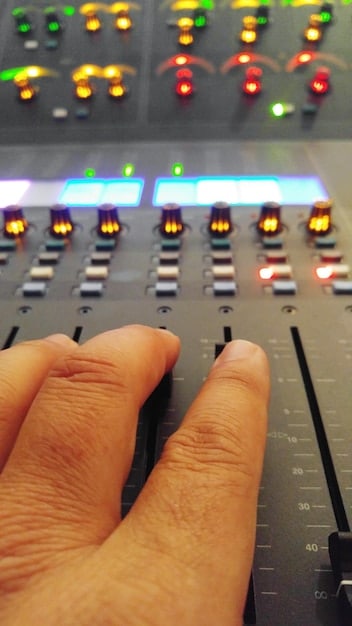
Re-recording or interpolating a musical composition is another viable alternative. This involves creating your own recording of a copyrighted song’s melody or chords, rather than sampling the original master recording. If you re-record the musical composition, you only need to obtain a mechanical license from the publisher, which is a compulsory license under US copyright law. This means the publisher must grant you the license, provided you pay a statutory royalty fee. This often bypasses the need for the more complex and expensive master use license needed for direct sampling of a sound recording.
The diverse range of alternatives to direct sampling provides a robust framework for underground producers to continue innovating and expressing themselves creatively, all while remaining firmly within the bounds of copyright law. These methods not only mitigate legal risks but also challenge artists to explore new sonic territories and refine their craft.
best practices for underground producers
Navigating the intricate landscape of copyright law is a significant challenge for underground music producers. To mitigate risks and foster a sustainable career, adopting a set of best practices is essential. These guidelines extend beyond mere legal compliance, encouraging a proactive and ethical approach to music creation and distribution.
education and awareness
The cornerstone of responsible music production is continuous education regarding copyright law. Producers should regularly update their knowledge on current legislation, landmark court cases, and industry standards related to sampling. Resources abound, including reputable legal websites, academic articles, and workshops specifically designed for musicians. Understanding the nuances of “fair use,” master use licenses, and mechanical licenses is not optional; it’s fundamental.
Engaging with the intellectual property community, attending music law seminars, and subscribing to industry newsletters can provide invaluable insights. An informed producer is a protected producer, capable of making deliberate decisions that safeguard their work and respect the rights of others.
meticulous documentation
For any creative work, meticulous documentation is a shield against future disputes. This applies doubly to tracks that might involve samples or elements derived from other sources. Keeping detailed records of every step in your production process can be crucial evidence if a copyright claim ever arises.
- Sample Sources: Document where each sample came from (e.g., royalty-free library, acquired license, self-recorded).
- License Agreements: Store all licensing agreements, emails, and payment receipts in an organized and accessible manner.
- Creative Process: Keep notes or project files detailing how you manipulated or transformed any borrowed material.
- Originality Evidence: Maintain clear records of your original compositions and sound designs, including dates of creation and any registrations.
This organized approach not only aids in legal defense but also simplifies future projects by providing a clear history of your sonic assets.
when in doubt, seek legal counsel
Perhaps the most critical best practice is knowing when to seek professional legal advice. While self-education is vital, it cannot replace the expertise of an entertainment lawyer specializing in copyright law. Before releasing any music that contains samples, especially if it’s intended for commercial distribution, consulting with a lawyer is highly recommended.
A legal professional can:
- Assess Risk: Evaluate the potential infringement risk of your specific sample use.
- Facilitate Clearance: Assist in identifying copyright holders and negotiating favorable licensing terms.
- Draft Agreements: Ensure all legal documents are sound and protect your interests.
- Represent You: Defend you in case of a copyright dispute or infringement claim.
While legal services come with a cost, it’s an investment that can prevent far more expensive lawsuits and reputational damage down the line. Many legal firms offer initial consultations, providing an opportunity to gauge the scope of their services and assess the specific needs of your project without immediate financial commitment.
Ultimately, a blend of legal literacy, diligent record-keeping, and strategic legal consultation forms the robust framework that enables underground music producers to create, innovate, and thrive responsibly within the highly interconnected world of contemporary music.
the future of sampling and copyright
The intersection of sampling and copyright law is not static; it’s a dynamic and often contentious space constantly evolving with technological advancements and shifting artistic practices. For underground music producers, anticipating these changes is key to sustained creativity and legal compliance. The future promises a blend of new challenges and potential solutions, driven by AI, blockchain, and ongoing discussions around artists’ rights.
technological impacts and ai
Artificial intelligence is rapidly reshaping music creation, including sampling. AI-powered tools can now generate original musical snippets, manipulate existing audio in unprecedented ways, and even identify samples within recordings. This presents both opportunities and new legal dilemmas. While AI can create entirely new, royalty-free sounds, the use of AI trained on copyrighted material raises questions about derivative works and original authorship.
The development of AI that can automatically clear samples or suggest legally safe alternatives is also on the horizon. Such tools could democratize legal sampling by making the clearance process more accessible and transparent, significantly benefiting independent artists who lack the resources of major labels. However, the legal framework around AI-generated content and its reliance on existing data sets will need to catch up, likely leading to new regulations and industry standards.
blockchain and transparent royalty tracking
Blockchain technology offers a promising solution for transparent and efficient royalty tracking and rights management. By creating immutable records of ownership and transactions, blockchain could streamline the process of clearing samples and ensuring that all rights holders automatically receive their due royalties. Smart contracts on a blockchain could automate licensing agreements, making micro-licensing for small samples feasible and reducing administrative overhead.
- Decentralized Rights: Artists could directly register their works and manage licenses without intermediaries.
- Automated Payments: Royalties from samples could be distributed instantaneously and proportionally to all contributors.
- Enhanced Transparency: Every use and payment would be recorded publicly, fostering trust and accountability.
This decentralized approach could empower independent artists by giving them greater control over their intellectual property and simplifying cross-border licensing. While still in nascent stages for widespread adoption in the music industry, blockchain has the potential to revolutionize how samples are licensed and how artists are remunerated.
The ongoing dialogue between legal experts, artists, and technology innovators suggests a future where sampling may become more regulated but also more accessible and equitable. As the lines between creation, appropriation, and distribution continue to blur, copyright law will undoubtedly adapt. Underground producers who remain informed and flexible will be best positioned to thrive in this evolving landscape, continuing to push creative boundaries while respecting the rights that underpin the entire musical ecosystem.
| Key Aspect | Brief Description |
|---|---|
| ⚖️ Dual Copyrights | Requires clearance for both sound recording and musical composition. |
| 🚫 Fair Use Limits | Rarely applies to commercial music sampling; strict criteria. |
| 📝 Sample Clearance | Complex process involving identifying rights holders and negotiating licenses. |
| 💡 Alternatives | Royalty-free sounds, original design, or re-recording offer safe options. |
frequently asked questions
▼
When sampling, you typically need to consider two main types of copyright: the copyright in the sound recording (also known as the “master” recording, owned by the record label or artist) and the copyright in the underlying musical composition (owned by the songwriter(s) and/or publisher). Both generally require separate licenses to legally use a sample.
▼
No, there is no “de minimis” rule or minimum length for a sample to be considered infringing in US copyright law. Even a very short or seemingly insignificant sample can lead to a copyright infringement claim if it is recognizable or qualitatively significant. It’s always safest to obtain permission regardless of length.
▼
Fair use is a legal doctrine that allows limited use of copyrighted material without permission for purposes like criticism, comment, news reporting, teaching, scholarship, or research. However, applying fair use to commercial music sampling is challenging, as courts rarely find such uses transformative enough to qualify, especially if it harms the market for the original work.
▼
Sampling without permission can lead to serious legal consequences. These can include cease-and-desist letters, injunctions to stop distributing your music, demands for financial compensation (including statutory damages which can be substantial), and potentially the surrender of all profits generated from the infringing work. It can also damage your reputation and future opportunities.
▼
Several safe alternatives exist. These include using royalty-free sample libraries and sound packs, creating entirely original sounds through synthesis and sound design, or re-recording copyrighted musical compositions yourself (which typically only requires a mechanical license, a compulsory license that is easier to obtain). These methods allow creative freedom without legal risks.
conclusion
The journey for underground music producers through the intricate landscape of copyright law, particularly concerning sampling, is undeniably complex. While the allure of incorporating iconic sounds can be creatively inspiring, the legal ramifications of unlicensed use underscore the need for vigilance and informed decision-making. By embracing education, meticulous documentation, exploring legal alternatives, and seeking professional guidance when necessary, producers can safeguard their artistic endeavors and contribute to a more respectful and legally sound music ecosystem. Understanding and adhering to these principles isn’t just about avoiding legal trouble; it’s about building a sustainable and ethically responsible foundation for a vibrant underground music scene.

